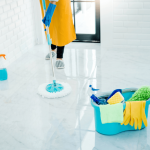How to Keep Your Child Safe By Anchoring the Furniture? A comprehensive Guide!
Why do we need to anchor the furniture is a big question. As kids investigate their surroundings because they are inherently interested. This naturally leads to climbing, which can provide unique home safety difficulties when child-proofing. However, climbing also helps kids learn and obtain fresh views. Daily objects like TVs, couches and appliances can fall over and injure people when they are in your home. To reduce this risk and ensure your family’s safety, anchor your appliances and furniture.
Why Should we Anchor the Furniture?
The most common causes of tip-over mishaps are children climbing onto, bumping into, or pulling up against furniture. Between 2000 and 2019, 451 children under the age of 17 were killed.when TVs and furniture toppled over, according to data from the U.S. Consumer Product Safety Commission (CPSC). Between 2017 and 2019, 11,100 youngsters on average visited the ER for injuries sustained in a tip-over incident per year. Roughly 79% of all furniture and TV tip-over fatalities involved children under the age of six, and a TV was involved in 75% of these incidents.
The dangers of unattended furniture are becoming more widely known thanks to activists. A foundation has been established in Shane’s memory by Lisa Siefert. She lost her 2-year-old son in 2011 due to a tip-over accident. Siefert’s research has revealed that a lot of families aren’t always aware of the complete range of unanchored furniture pieces that can be extremely dangerous.
The lack of complete control over these things presents a dilemma for many parents when it comes to home safety. Some parents have their children spend time in the houses of relatives, friends, and babysitters. Where mostly the furniture is not anchored, or they have rental agreements that forbid drilling into walls. When discussing child safety with others or requesting authorization to place anchors in someone else’s wall, parents could feel uncomfortable. It is possible to limit potential wall damage with non-drilling goods and choices, as well as to repair and patch drill damage with kits.

How can we Anchor the Furniture and What devices can be used?
Although many furniture anchors are also offered by internet shops, they might be hard to locate, especially in large US retailers. A wide range of parents’ needs can be satisfied by the assortment of anchoring devices available. We can use following devices to anchor the furniture
▪ Brackets And Cables: These devices usually have two brackets: one that is fixed to the wall and the other that is attached to the furniture. Furniture from toppling forward is prevented with a cable that is braided out of steel or nylon and linked to these brackets.
▪ Mounts: Free-standing, unsecured TVs pose a significant risk of tipping over. TVs can be directly attached to metal brackets that are then screwed into the walls.
▪ Zero-Screw Kits: There are devices on the market presently (some are classified as “patent pending”) that use adhesives, picture-hanging sized nails. Also maybe a strap system for persons who are unable to drill into their space’s walls or studs. Some of these items claim to be capable of preventing tipping by up to 200 pounds.
Most anchoring options necessitate some level of drilling. There are also wall repair kits available at hardware stores, other retailers, and online that can help to reduce wall damage.

What Types of Furniture Should Be Anchored?
Children may climb, pull up on, or bump into free-standing, heavy furniture in practically any room of your home. Furniture that is prone to tipping include:
Furniture items include ;
- Dressers,
- Desks
- Chests
- Bookcases and shelving units.
- TVs and TV stands.
- Tables
- Heavy chairs
- Ranges & Stoves: Freestanding
- Any tall and/or possibly shaky fur
Dressers, in particular, pose a high risk of tipping over. Dressers with full-extension drawers might tip forward due to the weight of the drawers and their contents.
In recent years, the standards organization ASTM International has introduced regulations. It requires dressers to bear up to 50 pounds of forward force without toppling. However, for many children, this may not be sufficient. Anchor your dresser and utilize drawer stops to limit how far its drawers can expand for maximum security and peace of mind.
How to Secure and Anchor the Furniture?
Although consumers have access to a wide range of anchoring products, there is a general criterion that they can adhere to. Screws must be installed into the studs before you can attach the anchor to the wall. Finding studs is easy with a stud finder tool; they are usually 16 inches apart.
When attaching the anchor to the furniture, it is critical to place it on strong wood. It can usually be located around the top or sides of the piece. Fabric or thin wood may not be strong enough to withstand forward force, leading to a tipping incident.
Although the majority of anchoring devices provide the hardware needed for a correct installation, parents sometimes need specialized tools. tools help them with the installation. To install furniture anchors correctly, you might need to use hammers, screwdrivers, drills, tape measures, and other everyday instruments.
Furniture That Is Safe for Children
There are child-safe furniture options available that prevent tips or limit the chance of children becoming pinned. For example, lowering the mattress of a cribs reduces its center of gravity, making it more difficult to tip over. In order to prevent kids from climbing to reach out and take stuff off the table, there are also child-safe tables available with height-adjustable tops.
There are dressers available constructed of lighter wood alternatives or plastic. These lighter materials lessen the chance of youngsters being pinned behind fallen furniture, which can lead to asphyxia. Additionally, certain contemporary dressers have stability measures that prevent drawers from being opened unless the furniture is fastened to a wall. Specific drawer straps can also be purchased to hold dresser and cabinet drawers closed.
Test the safety of your furniture
Furniture safety testing should be done by parents in order to assess and reduce the possibility of a child getting hurt. Testing the balance of free-standing furniture, such as dressers or bookshelves, should be part of this (even if they are anchored to the wall or floor). Make sure all flat-screen TVs and their cords are out of reach, and that any heavy or enticing items are out of sight. The viewpoint and climbing abilities of their children should be taken into consideration by parents.
When conducting a furniture-based home safety test, take into account these recommendations:
▪ All heavy, free-standing furniture should be anchored to the wall or the floor.
▪ Dressers with full-extension drawers should have drawer stops installed.
▪ TVs should be mounted high and out of reach on the wall.
▪ Should a TV not be able to be wall mounted, set it up on a stable, low-level platform, fastened to the furniture using a TV strap, and pushed back as far as you can.
▪ Keep all electrical cables out of children’s reach.
▪ To stop kids from reaching or climbing for remote controls and other appealing objects, keep them off of tables, dressers, and TV stands.
Teaching youngsters the dangers of climbing on large, heavy furniture or appliances, as well as playing with electrical cords, is a crucial step towards their safety. Helping kids make wise decisions when they are developmentally capable of understanding them can be empowering, but no safety product is ever 100% effective.
Why Child-Safe Furniture Is Important
Every year, hundreds of children lose their lives as a result of tip-over occurrences. Doing home safety assessments and anchoring the furniture are very vital. These safety precautions, however, do not completely address the issue even with them in place.
Click here to ream more informative articles like this or to book your free Consultation with one of our Specialist. Our Specialists are fully trained to make an assessment of your living space and help you anchor the furniture at your home.








